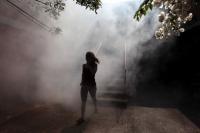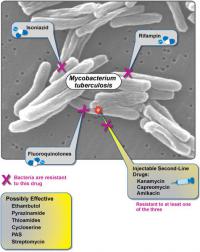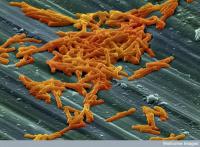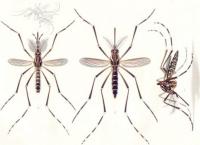-
Zika epidemic likely to burn itself out within three years

The current Zika epidemic in Latin America is likely to burn itself out within three years, suggests new research. The findings also conclude the epidemic cannot be contained with existing control measures. The researchers predict the next large-scale epidemic is unlikely to emerge for at least another ten years — although there is a possibility of smaller outbreaks in this time.
-
-
Widespread outbreak of Zika virus in U.S. unlikely: Expert
An infectious disease expert says that Americans should not concerned about a widespread Zika virus outbreak in the United States. “The density of mosquitoes in the United States is not what it is in other countries,” says the expert, a member of the World Health Organization Emergency Committee on Zika virus. “In order to sustain an epidemic, a large population of mosquitoes that are close together with a dense population of people is needed for Zika virus to transmit more efficiently.”
-
-
Lessons of 1976 Ebola outbreak analysis are relevant today
With the recent Ebola epidemic in West Africa reviving interest in the first outbreak of the deadly hemorrhagic fever 40 years ago, scientists have released a report highlighting lessons learned from the smaller, more quickly contained 1976 outbreak. “Key to diagnosis in 1976 was the relatively quick clinical recognition of a severe, possibly new disease by national authorities,” according to one of the researchers.
-
-
Second U.S. patient infected with superbug resistant to antibiotics of last resort
Scientists announced earlier this week that a second American patient has been infected with a superbug which is highly resistant to antibiotics of last resort. “We are very close to seeing the emergence of enterobacteria that will be impossible to treat with antibiotics,” said Lance Price of George Washington University.
-
-
FDA completes pre-approval inspection of Emergent BioSolutions’ anthrax vaccine manufacturing facility
Gaithersburg, Maryland-based Emergent BioSolutions Inc. last week announced that the U.S. Food and Drug Administration (FDA) had completed its Pre-Approval Inspection (PAI) of Building 55, the company’s facility for large-scale manufacturing of BioThrax (Anthrax Vaccine Adsorbed).
-
-
Zika threatens world's blood supply: Experts

Blood safety researchers say it is highly likely that the mosquito-borne Zika virus can be transmitted through blood transfusions and are calling for an evidence-based approach to protecting the blood supply from the threat of Zika virus.
-
-
Floridians uncomfortable with use of genetically modified mosquitoes to limit spread of disease
A small survey of residents of a Florida Keys neighborhood where officials hope to release genetically modified mosquitos to potentially reduce the threat of mosquito-borne illnesses such as Zika finds a lack of support for the control method.
-
-
Zika virus expert: Tourists should “think twice” about going to Disney World
A leading public health expert has warned tourists to “think twice” about visiting parts of the United States, including Walt Disney World in Florida, because of the future threat of the Zika virus in the country. Pregnant women and couples looking to conceive should be particularly wary of going on holiday to southern states such as Florida, Texas, and Louisiana, he said.
-
-
Predicting the spread of the Zika virus

Countries that are well connected to Brazil have been at particularly high risk of importation of the Zika virus, according to researchers. However, subtropical and tropical countries with a history of dengue and other mosquito-borne diseases have the greatest risk of the virus spreading once it arrives in the country.
-
-
Pennsylvania superbug infection could mean "the end of the road" for antibiotics: Researchers

Researchers have, for the first time, found a person in the United States carrying a bacteria resistant to antibiotics of last resort. Top U.S. public health officials say this is alarming, and could mean “the end of the road” for antibiotics. Researchers say that the discovery “heralds the emergence of a truly pan-drug resistant bacteria.”
-
-
New paper filter removes viruses from water

More than 748 million people around the world lack access to safe drinking water and basic sanitation. Water-borne infections are among the global causes for mortality, especially in children under age of five, and viruses are among the most notorious water-borne infectious microorganisms. They can be both extremely resistant to disinfection and difficult to remove by filtration due to their small size. Scientists have developed a simple paper sheet which can improve the quality of life for millions of people by removing resistant viruses from water.
-
-
Rapid detection of E. coli in water
Tragedies like the E. coli outbreak in Ontario’s Walkerton in May 2000 could be averted today with a new invention by researchers at York University that can detect the deadly contaminant in drinking water early. Anew technology has cut down the time taken to detect E. coli from a few days to just a couple of hours.
-
-
Biodefense Panel welcomes key provision in defense authorization bill
In October 2015, the Blue Ribbon Study Panel on Biodefense found that insufficient federal coordination on strategy, budgeting, and policy; inadequate collaboration with other levels of government and the private sector; and lagging innovation in areas like biosurveillance and medical countermeasure development make the United States vulnerable to biological attacks and infectious disease outbreaks. The Panel welcomed the passing by the House of the National Defense Authorization Act, H.R. 4909, which includes a provision addressing one of the Panel’s most important recommendations.
-
-
A tool to help public health decisions on Zika virus to be cost-effective

A new study presents a cost-effectiveness tool that can help guide decisions regarding resource allocation to fund interventions targeted at curtailing the ongoing Zika virus outbreak. Analyses using the tool suggest that proposed funds to combat Zika in the United States and other countries would be cost-effective, based on quantification of the serious health conditions associated with Zika infection.
-
-
Senate approves $1.1 billion to fight Zika virus
The Senate on Tuesday voted 68-29 to allocate $1.1 billion in emergency funding to fight the Zia virus threat. The funds fall short of the White House’s request of $1.9 billion, but are significantly more than House Republicans’ $622 million anti-Zika proposal. The House will debate the measure on Wednesday.
-
- All
- Regional
- Water
- Biometrics
- Borders/Immig
- Business
- Cybersecurity
- Detection
- Disasters
- Government
- Infrastructure
- International
- Public health
- Public Safety
- Communication interoperabillity
- Emergency services
- Emergency medical services
- Fire
- First response
- IEDs
- Law Enforcement
- Law Enforcement Technology
- Military technology
- Nonlethal weapons
- Nuclear weapons
- Personal protection equipment
- Police
- Notification /alert systems
- Situational awareness
- Weapons systems
- Sci-Tech
- Sector Reports
- Surveillance
- Transportation
Advertising & Marketing: advertise@newswirepubs.com
Editorial: editor@newswirepubs.com
General: info@newswirepubs.com
2010-2011 © News Wire Publications, LLC News Wire Publications, LLC
220 Old Country Road | Suite 200 | Mineola | New York | 11501
Permissions and Policies
Editorial: editor@newswirepubs.com
General: info@newswirepubs.com
2010-2011 © News Wire Publications, LLC News Wire Publications, LLC
220 Old Country Road | Suite 200 | Mineola | New York | 11501
Permissions and Policies
